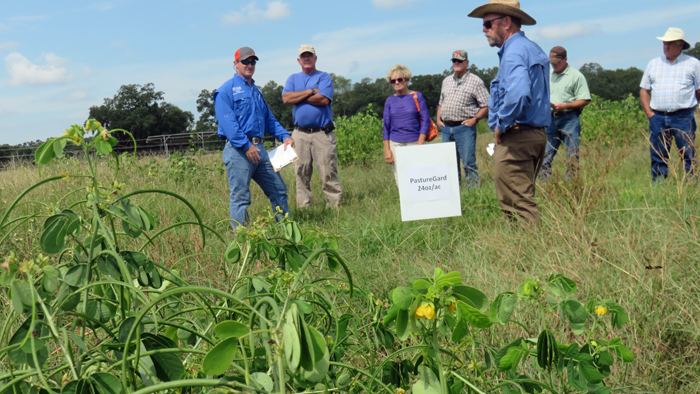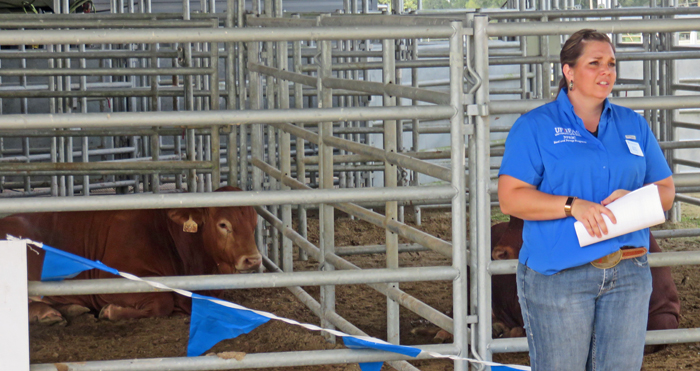
Over 120 cattle producers, extension agents, research faculty and staff attended the UF/IFAS Beef & Forage Field Day that was held on Friday, September 15, 2017 at the North Florida Research and Education Center’s Beef Unit, near Marianna, Florida. The event consisted of a tour of six demonstrations sites and a presentation at the main pavilion right before lunch. The NFREC Beef and Forage Program hosts a field day every 18 months, so that both fall and spring cattle and forage management can be highlighted.
Integrating Rhizoma Peanut into Grazing Systems
Dr Jose Dubeux, UF Forage Management Specialist shared the results of two years of data working on a project to integrate rhizoma (aka perennial) peanut into bahiagrass pastures to reduce nitrogen fertilization requirements and boost animal performance. He has compared a traditional system of bahiagrass and overseeded smallgrains that requires 100 pounds of total nitrogen fertilization per year, to a system with a Bahia/rhizoma peanut mixture plus an overseeded cool-season grass/legume mixture with only 30 pounds of nitrogen fertilization. Thus far the legume/grass pastures have provided comparable performance to the traditional grass pastures with lower nitrogen fertilization.
Brunswick Grass Overview
 Dr. Ann Blount showed tour participants how to identify a troublesome weed in Florida called Brunswick Grass. This weed is in the same family (Paspalum) as bahiagrass, but livestock do not like to graze it once it starts to mature. The main challenge with this weed is that the seed is of similar size and weight to Bahia, so it cannot be easily separated after seed harvest in the cleaning process. There are also no herbicides currently on the market that will control Brunswick grass without injuring bahiagrass.
Dr. Ann Blount showed tour participants how to identify a troublesome weed in Florida called Brunswick Grass. This weed is in the same family (Paspalum) as bahiagrass, but livestock do not like to graze it once it starts to mature. The main challenge with this weed is that the seed is of similar size and weight to Bahia, so it cannot be easily separated after seed harvest in the cleaning process. There are also no herbicides currently on the market that will control Brunswick grass without injuring bahiagrass.
A More Nitrogen Efficient Soil
 Drs. Sunny Liao and Cheryl Mackowiak discussed pasture fertilization and soil health. Integrating forages and livestock grazing into a crop rotation system can increase soil organic matter and the soil microorganisms that mineralize fertilizer into plant available nitrogen (PAN). With higher organic matter in the topsoil, plants can access more of the nutrients needed for growth. Because forages have extensive root systems, developed from longer growth periods than annual crops, soil organic matter is enhanced improving the productivity of a field. Future UF research will focus on how grazing management and forage systems affect soil health.
Drs. Sunny Liao and Cheryl Mackowiak discussed pasture fertilization and soil health. Integrating forages and livestock grazing into a crop rotation system can increase soil organic matter and the soil microorganisms that mineralize fertilizer into plant available nitrogen (PAN). With higher organic matter in the topsoil, plants can access more of the nutrients needed for growth. Because forages have extensive root systems, developed from longer growth periods than annual crops, soil organic matter is enhanced improving the productivity of a field. Future UF research will focus on how grazing management and forage systems affect soil health.
Weed ID and Control
 Mark Mauldin, Washington County Extension Agriculture Agent shared the results of a pasture weed control and fertilization demonstration. Eight different pasture herbicides were applied in strips so participants could see their effectiveness on the weeds in the demonstration plots as compared to untreated areas. He also showed participants a comparison of how mowing, fertilization, and herbicides impacted forage production versus untreated forages.
Mark Mauldin, Washington County Extension Agriculture Agent shared the results of a pasture weed control and fertilization demonstration. Eight different pasture herbicides were applied in strips so participants could see their effectiveness on the weeds in the demonstration plots as compared to untreated areas. He also showed participants a comparison of how mowing, fertilization, and herbicides impacted forage production versus untreated forages.
Balancing Hay with Commodity Byproducts
 Dr. Nicolas DiLorenzo, UF Beef Specialist and Doug Mayo, Jackson County Extension Director, provided a demonstration of supplementation needed for two different types of hay. The Beef Research Unit produces both bahiagrass and Bermudagrass hay to feed their cattle in the fall and early winter. Using the forage test results for the two types of hay and the requirements of a 1200 pound mature cow in late gestation, alternative supplements were measured out and displayed using five-gallon buckets. Five different byproduct feeds were discussed and compared for use for supplementing the nutrient shortfall of the two types of hay.
Dr. Nicolas DiLorenzo, UF Beef Specialist and Doug Mayo, Jackson County Extension Director, provided a demonstration of supplementation needed for two different types of hay. The Beef Research Unit produces both bahiagrass and Bermudagrass hay to feed their cattle in the fall and early winter. Using the forage test results for the two types of hay and the requirements of a 1200 pound mature cow in late gestation, alternative supplements were measured out and displayed using five-gallon buckets. Five different byproduct feeds were discussed and compared for use for supplementing the nutrient shortfall of the two types of hay.
Cracking the Bull Buying Code
 Kalyn Waters, Holmes County Extension Director and Ken Stewart, Southern Cattle Company discussed bull selection using the performance data provided through the different breed associations. They shared how producers can establish benchmarks to guide bull buying decisions using the information provided in sale catalogs to identify the bulls of greatest interest before viewing the bulls in person prior to a sale. With the combination of genetic performance data and visual appraisal, cattle producers can develop a budget and make wiser purchasing decisions as the sale progresses.
Kalyn Waters, Holmes County Extension Director and Ken Stewart, Southern Cattle Company discussed bull selection using the performance data provided through the different breed associations. They shared how producers can establish benchmarks to guide bull buying decisions using the information provided in sale catalogs to identify the bulls of greatest interest before viewing the bulls in person prior to a sale. With the combination of genetic performance data and visual appraisal, cattle producers can develop a budget and make wiser purchasing decisions as the sale progresses.
Carcass Merit of the Current US Beef Industry
 Dr. Chad Carr, UF Extension Meat Specialist shared a summary of the results of the 2016 National Beef Quality Audit. He highlighted several trends as compared to the previous audits made every five years since 1991. The main two trends he shared from the recent audit were that carcasses are getting heavier with some improvement in quality grade. The average carcass weight from the survey was 859 pounds, which was 67 pounds heavier than ten years ago, and 36 pounds more than five years ago. Of the 7,379 beef carcasses evaluated in the audit, 1% were 1,800 pounds live steers with carcass weights of over 1,100 pounds. Theses larger cattle also graded 71% choice and prime, as compared to 61% five years ago.
Dr. Chad Carr, UF Extension Meat Specialist shared a summary of the results of the 2016 National Beef Quality Audit. He highlighted several trends as compared to the previous audits made every five years since 1991. The main two trends he shared from the recent audit were that carcasses are getting heavier with some improvement in quality grade. The average carcass weight from the survey was 859 pounds, which was 67 pounds heavier than ten years ago, and 36 pounds more than five years ago. Of the 7,379 beef carcasses evaluated in the audit, 1% were 1,800 pounds live steers with carcass weights of over 1,100 pounds. Theses larger cattle also graded 71% choice and prime, as compared to 61% five years ago.
For more details on the information provided at the Field Day, use the following link to access the proceedings from the event:
2017 UF/IFAS Beef & Forage Field Day Proceedings
—
 0
0

